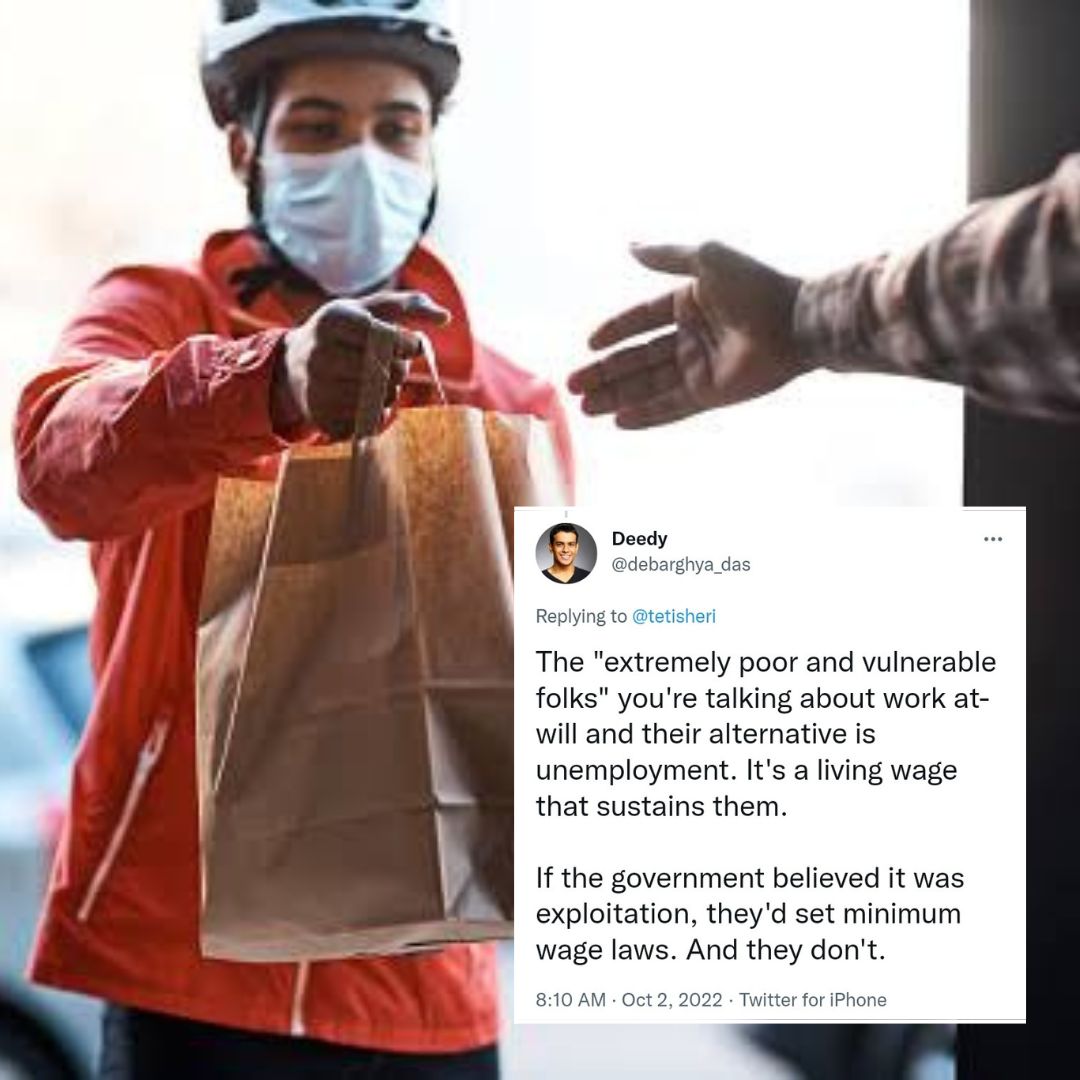Twitter Post Comparing India And USA's Delivery System Sparks Debate On Labour Conditions- Here's What Happened!
Writer: Laxmi Mohan Kumar
She is an aspiring journalist in the process of learning and unlearning many things. Always up for discussions on everything from popular culture to politics.
India, 5 Oct 2022 7:36 AM GMT | Updated 5 Oct 2022 9:13 AM GMT
Editor : Snehadri Sarkar |
While he is a massive sports fanatic, his interest also lies in mainstream news and nitpicking trending and less talked about everyday issues.
Creatives : Laxmi Mohan Kumar
She is an aspiring journalist in the process of learning and unlearning many things. Always up for discussions on everything from popular culture to politics.
Debarghya Das's recent Twitter post was all praises of the speedy food delivery system in India. However, this welcomed a controversy on the labour exploitation patterns and discussions on risks faced by delivery partners.
Debhargya Das, an engineer by profession, recently tweeted in praise of the speedy delivery system in India. The tweet, which compared San Francisco's 55-minute food delivery to that of less than eight minutes in India, had the netizens divided over their opinions on the delivery platforms.
Some claimed that his comparison was equivalent to comparing "apples to oranges", and others pointed out that Debhargya fails to look at the pressure that is being put on the delivery agents. Responding to the same, the user posted a thread of tweets discussing the labour exploitation that netizens believe occurs within the majority of the food delivery platforms.
Faster Food Deliveries: A Pro Or Con Of The Industry?
Instant delivery applications have always been a topic of debate on social media platforms. It has seen a range of people lauding the efforts put in for customer satisfaction and another range of people who believe that customer satisfaction is ensured through the sheer exploitation of delivery partners.
In a similar scenario, Debhargya's tweet that read,
In San Francisco, I've stopped using DoorDash because I'm paying $25 to wait 55mins to get a bang average cold sandwich.
— Deedy (@debarghya_das) October 2, 2022
In Bangalore, I just ordered the most mindblowingly mouthwatering hot biryanis from Meghana's for $5 and it arrived in EIGHT MINUTES! pic.twitter.com/2QuZ74A9U5
This is being discussed widely among the social crowds.
The tweet, which now has over 190 retweets and three thousand likes, has brought a very important discussion on the gig workers to the forefront once again.
A Twitter user by the name of Noopur wrote, "Yes because in India these platforms are able to exploit extremely poor and vulnerable folks for whom this is a low entry barrier job. The workers bear the risks and costs of the speeding up." Responding to this, Debhargya claimed that the vulnerable folks being discussed are working at their will, as their alternative without the gig would be unemployment.
Adding to it, Debhargya said that the income the partners earn through these platforms sustains them. He was of the opinion that if the government considered it to be a form of exploitation, there would be a minimum wage law set in place for the same.
The "extremely poor and vulnerable folks" you're talking about work at-will and their alternative is unemployment. It's a living wage that sustains them.
— Deedy (@debarghya_das) October 2, 2022
If the government believed it was exploitation, they'd set minimum wage laws. And they don't.
Which was then followed by more reactions.
Legality doesn't always imply morality. Slavery was once legal. Tip your drivers well - preferably in cash because platforms only pay out on the weekends.
— Mohit (@heisengarg) October 2, 2022
Another user who identifies as a non-residential Indian living in the USA said, "I see so many comparing US costs to India's. I don't think this is a fair comparison considering the lower cost of living and lower cost of blue collar labour in India."
Discussions On Labour Exploitation
The tweet posted by Debhargya followed up with another thread of tweets where he justified his take.
1/7 On labor exploitation from last tweet🧵
— Deedy (@debarghya_das) October 3, 2022
Zomato/Swiggy are highly unprofitable businesses.
Pay delivery partners more, prices increase. Prices increase, users decrease.
Users decrease, fewer jobs.
500k+ drivers in India making 1.5L+ yearly. Fewer jobs, worse income for them.
Dropping his two cents on the debate of labour exploitation, he commented that Zomato/Swiggy are businesses that are highly unprofitable. He claimed that if the delivery partners were paid more, prices would eventually increase, which would drop the number of users and have the business running on neck-deep losses.
Citing examples of the labour conditions in countries such as the United Arab Emirates, he said that the country has "egregious human rights violations". Commenting on the exploitation observed in these countries, he said that people work under inhumane work hours and are unable to quit in such spaces.
He concluded the thread with a criticism of the netizens. Calling them out for being mere armchair Twitter critics, he noted that the 25 million + Indians who use these platforms would do something about the issue if they truly cared about them.
This thread, as well, saw some people engage in a thought-provoking conversation where many people came out talking about how tough it is for delivery workers out there.
Delivery workers do have it tough. 15-16 hours on the road. Pressure of on time delivery, complaints , ratings etc. But it is a job. It pays between 15-25k post expenses. At those income levels, you start getting yourself out of poverty. Arm chair do gooders don't understand this
— Venkataramana Reddy (@tirumuru_87) October 3, 2022
Delivery Partners And Speedy Delivery Promises
To get more insight into the internal functionings of delivery platforms, The Logical Indian spoke to Abhiram Singh, a student who used to work part-time for two well-known food delivery platforms.
Talking about the income patterns, he says the money earned varied upon multiple factors. "I'd earn more than the usual, up to ₹150 for a delivery, if I delivered food on a rainy day or past midnight". Based on the distance, time, and weather conditions the partners choose to deliver food at, the incentives would vary.
So inevitably, those who are in need of more money would try to earn more incentives in a day by picking more orders during the odd hours. Talking about the time when Zomato's CEO had introduced the ten-minute delivery feature, he said "it was an option that the partner could opt for if they wanted to."
However, at the time it was introduced, the CEO faced severe backlash for putting the lives and livelihoods of many delivery agents at stake. After which, the CEO took to Twitter to clarify how the feature functions for specific nearby locations and popular and standardised menu items only. He further ensured that no penalties for late deliveries would incur upon the agents.
Today, many platforms continue to carry on the 10-minute delivery feature and bring in the idea of promising hyperlocal delivery within a blink. The markets became more competitive to see who reached the customers the fastest, and delivery agents were on the run to maintain those promises.
A report by Business Today quoted Shaik Salauddin, national general secretary of the Indian Federation of App-based Transport Workers, saying, " In the competition to become the fastest and acquire most customers, the lives of delivery partners are put at stake."
Also Read: Internet In Awe! Delivery Partner Carries Both Children To Work, Zomato Assures Child Care Benefits
 All section
All section















